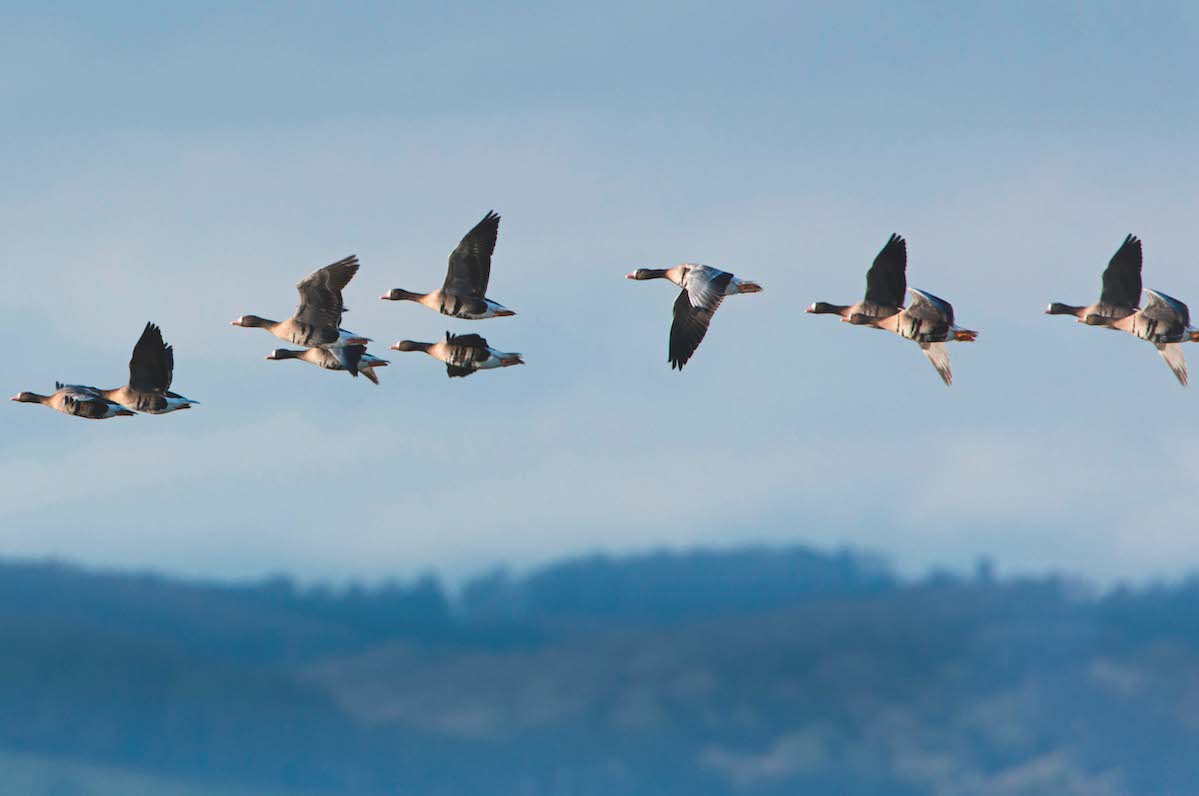White-fronted goose: where can it be found?
With its melodic call and nimble flight, the whitefronted goose is easy to spot, writes Charles Smith-Jones

More than 15,000 white-fronted geese overwinter in the UK and Ireland
The white-fronted goose is very much a winter visitor to the UK, breeding in Greenland and Siberia before moving south in search of a more clement climate. Arriving here from October onwards, the Greenland birds head mostly for Ireland and the west coast of Scotland, while those from Siberia spend the winter further south. Overall, more than 15,000 whitefronts overwinter in the UK and Ireland — roughly half the world population of Greenland white-fronts every year. (Read is the population of geese increasing so much?)
White-fronted goose quick facts
- Distribution: Breeds on the taiga and tundra of Alaska, Canada, Greenland and Siberia, migrating southwards in winter
- UK Distribution:A winter visit to the north and west of the British Isles (Greenland race) and further south (Siberian race), usually in highly localised parts of England and South Wales including Gloucestershire, the Hampshire Avon, Dyfed and the Welsh borders
- IUCN Red List status: Least concern, overall population trend unknown (though note comments on the Greenland race)
- Habitat: Overwintering birds can be found on coastal, wetland, grassland and farmland habitats
- Food: Roots, shoots, tubers, grasses, leaves, grain winter wheat, potatoes
- Breeding: Usually pair for life. The goose does all the sitting though the gander stands guard, and some observers believe that grandparenting is occasionally practiced. Both parents defend the goslings and, once reared, family parties stay together until the following breeding season
- Nesting: A shallow ground nest is built among grasses or dwarf scrub, often on slightly raised ground such as hummocks or slopes. It is constructed from plant matter and lined with down and other feathers
- Clutch Size: 3-7 eggs
- Incubation Time: 22-28 days
- Length (average): 65-76cm Males are typically larger
- Wingspan (average): 130-165cm
- Weight (average): 1.9-2.5kg
- Lifespan (average): Normally around six years, though over 25 years has been recorded. (Read how long do geese live for?)
- Flight Speed: Up to 50mph
- Shooting Seasons: England and Wales*: 1 September-31 January (inland), 1 September-20 February (below the high-water mark) Scotland: no open season Northern Ireland: no open season Isle of Man: no open season * Only the Siberian race of whitefront geese can be shot in England and Wales. The Greenland race cannot be shot anywhere in the UK. (Read more on shooting seasons here.)

Adult white-fronts can be easily identified by the large white patch above the beak
White-fronted goose characteristics
Rather smaller than a greylag but larger than a pinkfoot, the whitefront is another of the grey geese that are most widely distributed. It can be easily identified by the large white patch above the base of the beak that provides its name. Overall, it is a greyish brown, with a light grey breast dappled with dark blotches and bold black bars on the belly. (Read more on greylag geese here.)
Males tend to be larger, though there is otherwise no real difference between the sexes. The legs are orange; Siberian birds have pink bills while those of Greenland birds are orange and their plumage is darker. Immature birds possess neither a white bill patch nor the barred chest of the adult.
Vagrant visitor
By rights we should refer to the bird we encounter in the UK as the greater white-fronted goose, as there is also a lesser white-fronted goose, Anser erythropus. The latter is, however, only a vagrant visitor to our shores. Apart from being smaller, it is distinguished by a clearly defined yellow ring around the eye, a smaller bill, and the white facial markings extend higher up.
The whitefront is one of the noisiest of geese, often referred to as the ‘laughing goose’ for its musical high-pitched kow yow call. The calling of a flock has been likened to the sound of bells. Although gregarious, the whitefront is not as sociable as other grey geese and can be encountered in smaller parties or even pairs. Sometimes they will mix with greylags or pinkfeet.
Of all the grey geese, the whitefront is probably the most agile in flight, with the greatest capacity for acceleration, near vertical take-off and rapid, spiralling landing. Family bonds are notably long-lasting, with families remaining together throughout migration and on to the next breeding season, with associations between parent birds and siblings sometimes lasting throughout their lives.
Globally threatened
The Greenland race has declined alarmingly and is considered globally threatened, probably as a result of changing spring weather conditions combined with competition from the much larger and more dominant Canada goose on its breeding grounds. Excessive human disturbance by visiting tourists from cruise ships has also been blamed. In Britain, the winter population has reduced by some 60% over the past 25 years and it has been removed from the quarry list.
The Siberian race has fared far better, however, and is a locally abundant legal quarry for the English or Welsh wildfowler. Although there was an attempt to stop all shooting of white-fronted geese on the grounds that the races can be difficult to tell apart under field conditions, the distinct geographical separation of the migrant populations have made this unnecessary.
The white-fronted goose is superb table fare and comes with a deserved culinary reputation for its dark, richly flavoured meat. It’s recommended to empty the body cavity soon after shooting to assist cooling – geese are well insulated by feathers and down, so too much residual body heat can spoil the meat if it’s left too long.
As for all wild geese, the cook needs to remain aware that they have less body fat than their domestic cousins and must take care not to let the meat dry out during cooking. Although a goose can be skinned, many people prefer to leave the skin on as it imparts flavour.
There are many ways of cooking one, but in the opinion of many a simple roast is by far the best way to do it justice. (Read our recipes for goose here.)








